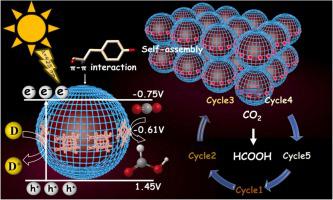当前位置:
X-MOL 学术
›
Appl. Catal. B Environ. Energy
›
论文详情
Our official English website, www.x-mol.net, welcomes your feedback! (Note: you will need to create a separate account there.)
Simultaneous integration of the photosensitizer hemin and biocatalyst nanoferrihydrite into a single protein nanocage for selectively photocatalytic CO2 reduction
Applied Catalysis B: Environment and Energy ( IF 22.1 ) Pub Date : 2023-11-17 , DOI: 10.1016/j.apcatb.2023.123521 Ruiqi Zeng , Xiaoxi Chang , Tuo Zhang , Chenyan Lv , Jiachen Zang , Guanghua Zhao
Applied Catalysis B: Environment and Energy ( IF 22.1 ) Pub Date : 2023-11-17 , DOI: 10.1016/j.apcatb.2023.123521 Ruiqi Zeng , Xiaoxi Chang , Tuo Zhang , Chenyan Lv , Jiachen Zang , Guanghua Zhao

|
The artificial photoreduction of CO into fuels with precious metal-based photosensitizers such as Ru, Re, and Ir represents a potential way to minimize global warming caused by the growing concentration of CO, but these noble metal-based photosensitizers present unsustainable and negative environmental impact issues, thereby limiting their applications. Herein, bioinspired by the inherent ability of ferritin (EcBFR) to bind to hemin, we constructed a photocatalytic-CO-conversion platform by using a single shell-like EcBFR molecule where up to 12 of hemin molecules can be incorporated into its intersubunit interfaces as photosensitizers, while the semiconductor photocatalysts nanoferrihydrites are catalytically synthesized and encapsulated within the protein inner cavity. Consequently, the constructed platform can selectively, effectively reduce CO to formic acid with 1-benzyl-1,4-dihydronicotinamide (BNAH) as the electron donor in aqueous solution under mild conditions. To improve the recyclability of the above platform, we designed a three-dimensional (3D) protein crystalline framework with the above constructed hybrid molecules as building blocks through π-π interactions. Notably, such protein framework enables the recyclability to be improved up to at least 5 cycles as compared to the individual protein nanocage. All these findings pave the way for CO photoreduction by naturally occurring heme as the photosensitizer in an environmentally friendly manner.
中文翻译:

将光敏剂氯化血红素和生物催化剂纳米水铁矿同时集成到单个蛋白质纳米笼中,用于选择性光催化二氧化碳还原
使用钌、铼和铱等贵金属基光敏剂将二氧化碳人工光还原成燃料,是最大限度减少二氧化碳浓度不断增加导致的全球变暖的潜在方法,但这些贵金属基光敏剂对环境造成了不可持续的负面影响问题,从而限制了它们的应用。在此,受铁蛋白 (EcBFR) 与氯化血红素结合的固有能力的生物启发,我们通过使用单个壳状 EcBFR 分子构建了一个光催化 CO 转化平台,其中多达 12 个氯化血红素分子可以掺入其亚基间界面,如下所示光敏剂,而半导体光催化剂纳米水铁矿被催化合成并封装在蛋白质内腔内。因此,所构建的平台可以在温和条件下以1-苄基-1,4-二氢烟酰胺(BNAH)作为电子供体在水溶液中选择性、有效地将CO还原为甲酸。为了提高上述平台的可回收性,我们设计了一个三维(3D)蛋白质晶体框架,其中上述构建的杂化分子通过π-π相互作用作为构建块。值得注意的是,与单个蛋白质纳米笼相比,这种蛋白质框架能够将可回收性提高至少 5 个循环。所有这些发现为通过天然存在的血红素作为光敏剂以环境友好的方式进行CO光还原铺平了道路。
更新日期:2023-11-17
中文翻译:

将光敏剂氯化血红素和生物催化剂纳米水铁矿同时集成到单个蛋白质纳米笼中,用于选择性光催化二氧化碳还原
使用钌、铼和铱等贵金属基光敏剂将二氧化碳人工光还原成燃料,是最大限度减少二氧化碳浓度不断增加导致的全球变暖的潜在方法,但这些贵金属基光敏剂对环境造成了不可持续的负面影响问题,从而限制了它们的应用。在此,受铁蛋白 (EcBFR) 与氯化血红素结合的固有能力的生物启发,我们通过使用单个壳状 EcBFR 分子构建了一个光催化 CO 转化平台,其中多达 12 个氯化血红素分子可以掺入其亚基间界面,如下所示光敏剂,而半导体光催化剂纳米水铁矿被催化合成并封装在蛋白质内腔内。因此,所构建的平台可以在温和条件下以1-苄基-1,4-二氢烟酰胺(BNAH)作为电子供体在水溶液中选择性、有效地将CO还原为甲酸。为了提高上述平台的可回收性,我们设计了一个三维(3D)蛋白质晶体框架,其中上述构建的杂化分子通过π-π相互作用作为构建块。值得注意的是,与单个蛋白质纳米笼相比,这种蛋白质框架能够将可回收性提高至少 5 个循环。所有这些发现为通过天然存在的血红素作为光敏剂以环境友好的方式进行CO光还原铺平了道路。

































 京公网安备 11010802027423号
京公网安备 11010802027423号